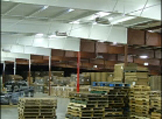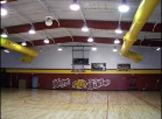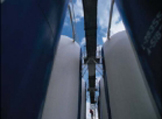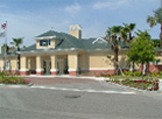Painting Terms

Learn Painting Terms - C
Browse Our Painting Terms
Calcimine - A water-based white or tinted paint made of whiting, glue, coloring matter and water, used as a wash for interior plaster. Any calcimine coat must be covered by a prime coat prior to application of a finish coat of paint.
Calcium Carbonate - Commonly called chalk, it's used in lime and portland cement, and as a paint extender and colorant.
Camel Hair - Trade name for tail hair from various types of Russian squirrels. Used for sign writer, lacquering brushings and lettering quills.
Casein Paint - Paint in which a casein solution takes the place of the drying oils of common paints. For outdoor use, lime and cement supply the hiding property; for inside work, it's lime, powdered chalk or kaolin. The paint is sold as a powder, to be mixed with water for use.
Cat Eye - A flaw or skip in the finish coat, also called a holiday, cat face, skipper or fish eye.
Catalyst - Substance whose presence increases the rate of a chemical reaction. In some cases, the catalyst functions by not being consumed and regenerated; in other cases the catalyst seems to not enter the reaction and functions by the virtue of surface characteristics of some kind. A negative catalyst (inhibitor, retarder) slows down a chemical reaction.
Catalytic Coating - Any coating which hardens due to a chemical reaction instead of drying.
Caulk - A generic term for a compound used to fill cracks, gaps, seams and joints.
Caulking - The process of filling cracks and crevices where materials meet, especially at door jambs and windows. Caulking compounds are applied with a putty knife or caulking gun.
Caulking Compound - A semidrying or slow-drying plastic mastic material used to seal joints or fill cracks and crevices.
Caulking Failure - Loss of protective seal due to loss of initial adhesion and flexibility. Usually caused by filling too large of an opening; wrong type of caulk; aged non-acrylic caulks; or prolonged contact with water.
Caulking Gun - A tool for expelling caulk from a tube. It enables a "bead" of material to be applied to cracks and seams.
Ceiling Paint - A thick, flat coating, sometimes tinted to reduced glare.
Cellosolve - Proprietary name for ethylene glycol monoethyl ether. A slow evaporating, water miscible, relatively strong solvent often used in epoxy coatings.
Cellulose Acetate - Any of several compounds produced by the action of acetic acid or acetic anhydride upon cellulose in the presence of concentrated sulfuric acid. Used as a paint binder and in the making of varnish.
Cellulose Nitrate - Any ester of nitric acid and cellulose. It is highly flammable, soluble in ether and alcohol or organic solvents and used as a base in making many paints and lacquers. Also called nitrocellulose.
Cementitious Coating - A coating containing Portland cement as one of its components held on the surface by a binder.
Centipoise - One hundredth of a poise which is a unit of measurement for viscosity. Water at room temperature has a viscosity of 1.0 Centipoise.
CFM (cfm) - Cubic feet per minute.
Chair Rail - A wooden or plaster molding which protects a wall from damage from the backs of chairs.
Chalking - Deterioration of the surface of an exterior paint upon weathering into a faded, powdery substance. Chalking occurs when the paint's binder is degraded by harsh environmental conditions. Chalk should be removed prior to repainting.
Cheapener - A slang term for a paint extender.
Checking - Patterns of short, narrow breaks in the top layer of paint. Checking occurs when the paint loses its elasticity.
Checking/Flaking - Aging dried paint getting hairline cracks that eventually crack to the surface. Usually caused by poor surface preparation; old oil-based paint that becomes brittle; applying paint too thin; delaminating of unprotected wood; or substrate cracking underneath.
Chemical Resistance - The ability of a coating to resist damage by chemicals.
Chemical Stripping - The process in which paint removers or chemical stripping materials are used to soften existing paint for removal by scraping and/or flushing.
Chime - The lip around the opening of a paint can into which the lid is placed.
Chipping - Small pieces of paint removed from the surface, typically a sign of physical damage. Use of a surface tolerant primer for touch up followed by the same finish coat generally solves the problem.
Chlorinated Hydrocarbon - A class of strong, fast evaporating, nonflammable solvents such as carbon tetrachloride, methylene chloride or trichloroethylene.
Chlorinated Rubber - A coating resin formed by the reaction of rubber with chlorine gas. Often used for chemical or water resistant properties.
Chroma - A measurement of color. The degree of saturation of a hue. A color at its full intensity has maximum chroma.
Clay - A white, mined mineral used as an extender - mostly in interior paints.
Clean and Dry - The condition of the surface prior to painting. The surface shall be clean, dry, and free of oil, grease, wax, form oils, and any other contaminant that may effect the adhesion of the coating.
Cleaner - A detergent, alkali, acid or similar contamination removing material, which is usually water borne.
Clear Coating - A transparent protective and/or decorative film.
Clip - A drywall slang term for additional wall area above the 8'0" ceiling line at a vaulted, cathedral, or high ceiling.
Closed Abrasive Blast Cleaning - An abrasive blast cleaning operation which is carried out within a shroud or an enclosure that surrounds the abrasive stream and forms a seal with the surface being cleaned. A vacuum is applied to the shroud to collect both the spent abrasive and material being removed from the surface and to prevent them from escaping into the environment.
Close-grain Wood - Hardwood lumber which has narrow, inconspicuous annual rings and tight Pores.
Clouding - Loss of luster, shine or gloss caused by a porous undercoat.
Cloudy - A painted surface which has not been uniformly coated.
Coal Tar - A dark brown to black cementitious material produced by the destructive distillation of bituminous coal.
Coal Tar Enamel - A bituminous black coal liquid used to coat vessels.
Coalescence - The formation of resinous or polymeric material when water evaporates from an emulsion or a latex system, permitting contact and fusion of adjacent particles; fusing or flowing together of liquid particles.
Coalescence Void - Paint not forming a continuous film when surface temperature is too cold. Usually caused by - painting when the air or surface temperature is below 50 degrees F.
Coalescent - An organic solvent used in latex paints that acts as a temporary plasticizer, to aid in film formation. It helps the binder form a continuous film when applied, particularly at the low end of the application temperature range recommended for the coating.
Coalescent Aid - The small amount of solvent contained in latex coatings. Not a true solvent since it does not actually dissolve the latex resins, the coalescent aid helps the latex resins flow together, aiding in film formation.
Coalescing - The settling or drying of an emulsion paint as the water evaporates.
Coat - A film or layer of paint or other liquid material applied in a single operation.
Coating - (1) A paint, stain, varnish, lacquer, or other finish that both protects and provides decoration to the substrate. (2) The process of applying a coating to the surface of an object or material.
Coating Atomization - The process of atomizing a coating material so that it may be applied to a substrate.
Coating Material - A material deposited in a thin layer or film onto a surface, to which it adheres.
Coating Material Failure Analysis - The process of determining why a coating on a substrate did not perform as expected.
Coating System - Paint products used together to cover the same surface. The film may be the result of primer, undercoat and topcoat (also called finish coat).
Coating-In - Applying a uniform coat of paint.
Cobwebbing - Premature drying of a coating during spraying causing a spider web effect.
Cohesion - The ability of a coating to hold together (the attraction of molecules within the coating).
Cold Checking - Checking caused by cold weather.
Cold Chemical Paint Stripping - The process of removing paint using chemicals, not heat.
Cold Cracking - Cracking caused by cold weather.
Cold Water Paint - A paint where the binder or vehicle is composed of glue, latex, casein and other components dissolved in water.
Collusion - A secret agreement for fraudulent or illegal purposes. A conspiracy.
Color Chip - A color sample usually consisting of a paint applied to a small piece of card (a chip).
Color Coding - Identification of electrical wires or piping.
Color Fast - Nonfading.
Color Person - An expert at blending and matching colors.
Color Retention - The ability of paint to keep its original color. Major threats to color retention are exposure to ultraviolet radiation and abrasion by weather or repeated cleaning.
Color Uniformity - Ability of a coating to maintain a uniform or consistent color across its entire surface, particularly during the weathering process.
Color Wheel - A circular diagram in which primary and intermediate colors are arranged so that related colors are next to each other and complementary colors are opposite
Colorant - Concentrated color (dyes or pigments) that can be added to paints to make specific colors
Colorfast - The ability to maintain color and not fade excessively under normal conditions.
Coloring Pigment - A pigment or stain which is added to a paint when the final color desired is different from the original color.
Combustible - Refers to any liquid with a flash point at or above 100oF (37.50C).
Commercial Paint - Paint material that is used primarily in commercial applications as opposed to military, industrial or aeronautical applications.
Compatibility - The ability to mix with or adhere properly to other coatings without detriment.
Complementary Colors - Two colors directly opposite one another on the color wheel.
Condensation - The act or process of changing a substance from a vapor to a liquid state due to cooling.
Conduction - Heat transfer through a solid material by contact of one molecule to the next. Heat flows from a higher-temperature area to a lower-temperature one.
Confined Space - Any area where dilution ventilation cannot take place, or where air flow is obstructed.
Conical Mandrel - An instrument used to evaluate a coating's resistance to cracking when bent over a specified radius.
Consistency - The resistance of a paint to flow. A paint with high consistency flows slowly; a paint with low consistency flows readily.
Construction Specification Institute (CSI) - The organization that has established a format for construction specifications. The format includes 16 Divisions under four headings - Bidding Requirements, Contract Forms, General Conditions, and Specifications.
Contact Cement - Completely non-staining cement. Ideal for applying wall paneling and for covering counters, cabinets and table tops with both porous and non-porous surfacing materials ranging from linoleum to plastic laminates.
Contamination - The deposit, absorption, or adsorption of biological or chemical agents (including the growth of bacteria or fungi) on or by materials, structures, areas, personnel, or objects.
Contract - A written document that spells out exactly what the painting contractor will do and the exact amount he or she will charge. Unlike a bid, this is a legal, binding document. Insist on a contract. Both parties should sign.
Contrasting Colors - Colors separated by at least three others on the color wheel.
Copper Staining - Usually caused by corrosion of copper screens, gutters or downspouts washing down on painted surfaces. Can be prevented by painting or varnishing the copper.
Corbel - A short piece of wood, stone or brick projecting from the face of a wall to form a support for a timber.
Cornice - Projection at the top of a wall; the construction under the eaves or where the roof and side walls meet; the top course, or courses, of a wall when treated as a crowning member.
Corrosion - Disintegration, deterioration, or away of a material by rusting and oxidation.
Corrosion Inhibitive - A type of metal paint or primer that prevents rust by preventing moisture from reaching the metal. Zinc phosphate, barium meta borate and strontium chromate (all pigments) are common ingredients in corrosion-inhibitive coatings. These pigments absorb any moisture that enters the paint film.
Corrosion Resistant - Ability of a substance to resist deterioration due to a chemical reaction with its environment. Coatings that do this usually contain a corrosion inhibitor.
Coverage - The area over which a given amount of paint will spread and completely hide the surface. Coverage, also known as spreading rate, is normally expressed in square feet per gallon or in square meters per liter.
Cracking - The splitting of a dry paint or varnish film, usually a result of aging or movement of the substrate. Different forms are hair-line cracking, checking, crazing, grain cracking, or alligatoring.
Crawling - A defect in a painted surface where the film breaks, separates or rises, because the paint was applied over a slick or glossy surface.
Crazing - A minute cracking of a finish coat of paint due to uneven shrinking of paint.
Creeping - A condition where the paint forms into small droplets caused by improper cleaning of wax, grease or dirt from the applied surface.
Creosote - A liquid coating made from coal tar once used as a wood preservative. It has been banned for consumer use because of potential health risks.
Crocodiling - (See Alligatoring)
Cross Spraying - Spray painting in two directions which cross each other.
Crystalline Silica - See Silica.
Curing - The process whereby a liquid coating becomes a hard film.
Curtain - A scallop effect which occurs when paint sags or runs down a vertical surface.
Custom Color - Special colors that are made by adding colorant to paint or by intermixing paints of different colors
Cut-In Trim Guide - A tool to protect adjacent surfaces when painting up against them.
Cutting In - The painting of a surface adjacent to another surface that must not be painted. For example, painting the frame of a window but not the glass.
Call Now - 1.800.354.9165 - Toll Free









